American Sabbatical 71: 3/15/97
Topsail Daytrips
3/15.. Wilmington.
While a coastal storm lashed Topsail Island, we caught up with our puting, did laundry, and
took the Owl for a lube job. The scene at Jiffylube was comical.
They were breaking in two trainees, and sicced both on poor Red.
The young woman managed to deflate one tire almost completely
trying to put in 4 pounds of pressure, and the young man had Red’s
air system totally disassembled before he discovered he had no
replacement filter. I watched with amused patience, and saw the
shop manager doing the same, out of the corner of my eye. When
they turned their skills on a woman customer’s red Camaro, and
proceeded to pump a quart of oil onto her hot engine, the manager
jumped in to shut the pump off, and calmly explain the nozzle
controls, without once raising his voice. I was impressed. The
car owner was bug-eyed with shock. I turned away to stifle a laugh.
Red didn’t say anything.
Back on the island Peggy kept emptying the pots and bowls she
had lined up under the leaks, where Lyle’s landlord still hasn’t
repaired the roof after the hurricanes. But they’re lucky to have
a roof at all, to judge from the devastation up and down the beach..
and as far as 50 miles inland. This is a blasted landscape, with
big trees uprooted or snapped off clean, trailers disintegrated
and their frames twisted like pretzels, mounds of debris everywhere,
and contractors’ trucks in every driveway. The piney woods in
all directions look like some crazed loggers have been at work.
Where the blowdowns have been cut up there are immense piles of
slash, or strewn acres of it left lying among the lacerated survivors.
How much the monocropping of pine plantations is to blame for
the uprooting, I couldn’t say. But the mixed growth jungles looked
less ravaged to me, although endless acres of sandy and marshy
flats don’t charm me, regardless of the veg.

Topsail Gull
|
I finally got sick of being cloistered, and at the edge of dark
I put on my raingear and stomped out into the weather. It immediately
stopped downpouring, and a thick ocean mist enclosed me. The residual
winds were southerly, and mild, full of Floridian promises. I
quickmarched along the foot of the beach until the last streetlight
was just an orange glow behind me. The iridescent surges roaring
out of the blackness carried balls of foam up to my feet, and
I scooped one up and stuffed my face in it: pure Atlantic essence.
Dripping with delight I finally hobbled back to camp around 8PM. |
Lyle had reported back from duty, and had his fellow officer (and
“reality check”) Kevin with him. They’d made reservations at the
one island restaurant Lyle said was fit to take us to. After waiting
tables at the River Cafe (a high end joint in Brooklyn) for a
couple of years, Lyle tends to be fussy. So we hopped in the limo,
a mudcolored 1967 Rambler American with a full-throated exhaust,
and hot-rodded to dinner.
These young Marines are great. I once might have sneered at their
gung ho, and considered their righteous militarism the highwater
mark of a jingoistic culture, but it doesn’t take long in their
company to blow away a Sixties prejudice. Vibrant and energized,
these guys are thorough realists about the modern military and
its mission, critical of equipment shortcomings and service politics,
witty and articulate, and just plain fun to be with. Kevin is
an avid scholar of history, and he had Peggy embroiled in animated
discussions before the alligator appetizers were delivered.
When talk turned to the Civil War, I asked if he’d read Grant’s
Memoirs, and he hadn’t, but his first remark about Grant cut right
to the essence of the man through all the historical fog. “He
out-generalled Lee,” Kevin said, “because he out-thought him.
His ability to visualize grand strategy and to articulate tactics
on paper so others could follow his orders were the key.” It had
taken me a month of reading Grant to come to that conclusion.
And the stated conclusion that clear writing leads to clear thinking
(or vice versa) is reassuring doctrine to hear from a Young Turk
in this age.
Over monkfish tails these Looies regaled us with tales about military
hardware. How they are expected to fight a war with antiquated
computers and patched up software, for example. Or fulfill riverine
missions with the hotdog boat Kevin operates. It is a glorified
jetski, with twin 300HP supercharged diesels blowing pressurized
streams aft, joyriding up to 45 knots with as much weaponry as
they can load aboard. There are “buckets” that can be lowered
into the jet streams, so the boat can go from full speed ahead
to a dead stop in two boat lengths, scoot sideways at 10 knots,
or spin on a dime, all in two feet of water. Only trouble is the
twin 300s are cooled with outside water intakes, and the riverine
muck blows the engines if they do anything full tilt boogie. Kevin
suggests that maybe the Navy wasn’t so stupid to turn over riverine
warfare to the Corps (especially considering the losses in Viet
Nam), and wondered at the economics of designing and perfecting
a mega-jetski when some big Whalers off the shelf would do the
job.
By the time I was sampling key lime pie any doubts I had about
critical awareness in a volunteer service were experiencing redeployment.
Was the Cold War the fulfillment of Eisenhower’s nightmare? The
big boondoggle of a military-industrial complex pushing a self-fulfilling
Soviet policy? Is today’s military procurement system the biggest
corporate welfare scheme in history? Do politicians manufacture
military adventures for dubious reasons? Maybe. But if we have
to have military readiness, this crop of young Marines makes me
feel good about who’s in the front lines.
| Saturday morning we got a full dose of gung ho. Lyle and Kevin
were competing in a 10K run on an impossible course at Camp LeJeune,
and we went to spectate. This is the heart of Devil Dog county,
Leatherneck capitol of the East, and LeJeune has the special ambiance
of all bases: old tanks, helicopters, howitzers and such, on display
in front of battalion headquarters, acres of mauled or hot-topped
landscape, and what Kevin calls Soviet Block architecture (rows
of cinderblock enlisted quarters), flags everywhere. Lyle swung
the limo into a lot full of hot cars, and we sloshed out across
a muddy playing field to the race starting line. |
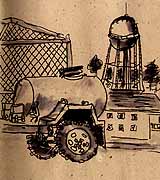
LeJeune Scenery
|
Peggy whispered in my ear “Hunk City,” and I had to admit that
I'd never been on a field with as many healthy animals. Even the
women had hard muscles.. and fighting tattoos. After a day of
deluge the course was even more absurd than anticipated, but the
limbering athletes were laughing and slapping, and a DJ on a stage
was cranking everyone up with streetwarrior music. If you aren’t
into bods, a crowd of Marines is also a phrenologists paradise.
I mean NO hair.. and ears!..if you have an interest in the varieties
of vibrational cartilage, the Camp LeJeune collection is museum
quality.
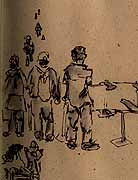
Race Finale
|
And they were off. Hundreds of contestants, military, university,
and civilian, stretched out into a colorful millipede and disappeared
into the woods. Forty-some minutes later runners came squishing
up to the finish. Some of the mudholes on the course were shoulder-deep,
and everyone was brown to the neck, and had their faces camouflaged.
There were only a handful of spectators, spouses with little kids
and dogs mostly, and we all were breathing deeply and standing
taller as the runners strode in. Lyle and Kevin were well up in
the pack, but nobody seemed interested in their personal standing.
They rehydrated and cheered one another, and headed off to the
showers. Another fun morning at camp. |
We wished Kevin the best, and hoped we see him again. Then Lyle
navigated us toward Wilmington through the blasted pines and wetlands.
We must have backdoored into Wilmington, because we were out strolling
the waterfront before I realized we were in a city. Actually there
are only 60,000 people in this port, and it has much the flavor
as Portland, ME, or Portsmouth, NH. Restored waterfront and old
center, with carriage rides and brick pavements, antique shops
and period restaurants. No particular period, just stylishly antiquated.
We lunched at the River Inn, and the cute gay waiter with a luscious
local accent made a broad pass at Lyle. We ate ferns and tripe...
or was it..
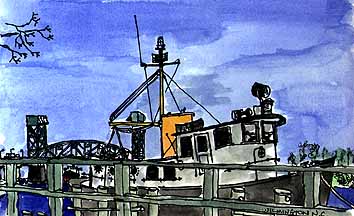
Wilmington
Lovely, though, in the low 70s without a cloud, and just enough
breeze to ruffle the Cape Fear River alongside the battleship
North Carolina and the scenic tugs. A skeletal lift bridge downstream
framed a wide-bellied bulk carrier, and a row of Indian red loading
cranes along the bank beyond looked like sculptural dancers doing
leg lifts.
We carried on to Orton Plantation, some dozen miles or so beyond
Wilmington, and watched the shadows lengthen over reclaimed rice
paddies and ornamental gardens. YES: the azaleas are in full bloom
on the Carolina coast, along with camellias, wisteria, and hosts
of flowering trees. We entered the plantation grounds through
a corridor of over-arching live oaks, and the classic Greek Revival
mansion house (straight out of Gone With the Wind) sits under
a pair of these venerable giants, surrounded by profusions of
blossoms.
The signs by the entrance warned that we should keep an eye out
for "Buster," the resident alligator, who suns himself on the
lawn by the pond. And there he was, lying motionless across a
small inlet from the promenade. He could of been rubber, of course.
I tried to convince a young photographer to go around and poke
him, but he offered to take a picture of me doing it. Well, they’d
promised an alligator, and delivered.. at $8 a head, no tour.
These mom and pop plantations are a caution.
(Memo #62)
March 15 Orton Plantation grounds
Who? “King” Roger Moore
What? RICE plantation, gardens
Where? on Cape Fear River near Wilmington, N.C
When? built 1725, constant additions and changes since
How? rice plantation then private home with garden tour
Topics: rice plantation, plantation images
Questions: How much variation is there among rice plantations?
How do they and how don't they fit our images of plantations? |
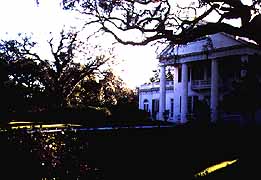
Orton Plantation
|
Although we didn’t see the interior of the mansion, and there
weren’t really any plantation outbuildings, Orton Plantation was
worth the visit. We got a sense of the landscape, a walk through
azalea gardens, and our first view of rice fields and the whole
canal and sluice system that created them.
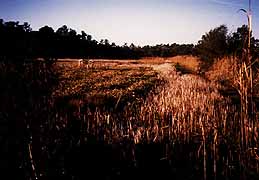
Rice paddy
|
The plantation is on the Cape Fear River southeast of Wilmington.
A lane of huge, gorgeous live oaks started us toward the mansion
and then we were out of the trees and in view of the old rice
fields with the river beyond. The Orton mansion’ s facade (white
columns, long windows) has been used in a variety of movies, including
“Young Indiana Jones”, ”Firestarter”, and “Lolita”. It is very
different from the architecture of Somerset Place (three story
wood) or the brick of the James River manses. |
The common image of the South links plantations to slaves and
cotton, cotton and slaves. Yet, cotton did not become a major
cash crop in the South until after Eli Whitney perfected the cotton
gin (from “engine”) to deseed the bolls in the 1790’s. It was
the industrial revolution (the textile mills increasing demand
and the cotton gin increasing production) that made cotton king.
Before 1800 the main crops of the southern plantations were tobacco
(Virginia), rice and Indigo (the Carolinas).
One historian I read said the rice plantations of the coastal
Carolinas were the
greatest engineering feat of the colonial period. Coastal swamps
were drained, cleared, leveled, diked. Canals and backwaters (storage
reservoirs) were created. Water had to be carefully controlled,
with the fields drowned part of the growing season, drained dry
at other times. Efficient sluice gates and an extensive canal
and dike system were keys to success. The canals and dikes required
constant maintenance, work that was impeded by heat, animals (snakes,
alligators etc.) and malaria. The rice fields have been long abandoned
and they serve now as luxury forage for migrating birds (once
fought as pests). But the rectilinear shapes of the paddies are
still there and you can see the canals and dikes and vestiges
of the sluices. The rice is now semi-wild and a yard tall in March.
The rice fields stretch from the river to the woods, covering
tens of acres. |
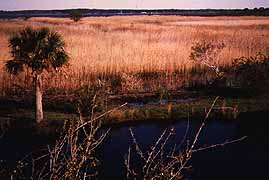
Orton View
|
The road followed a dike and then entered the mansion house grove.
The price seemed steep for a garden tour, though we were told
we might see Buster the gator sunning by the pond (we did and
wondered if he was stuffed - we didn’t check). The mansion is
surrounded by huge live oaks (some six feet in diameter) which
are dotted with Spanish moss and growing orchids. Lush lawns and
huge azalea banks (now in bloom) form irregular garden areas.
A lower terrace has a formal garden with gorgeous flower beds
edged in monkey grass. Below that is the pond and beyond the rice
fields. A path to the family graveyard winds through live oaks
and azaleas, a Chinese bridge crosses the pond. Beautiful.
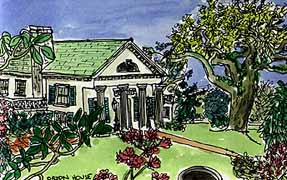
Orton Plantation
3/16... Moore’s Creek.
We backtracked from Orton Plantation to our base on Topsail Island, taking an alternate route through
the blasted pines and across Wilmington’s mall-sprawl. Our impression
of a charming old city by a tidal inlet got flattened out and
developed all over. Wally and Mac, along with the Colonel and
his militia, have taken the outskirts and yanked them into another
characterless American burb. Acres of auto lots and chain stores
surround UNC Wilmington and amoeba out into the least trailer
park. It was almost a relief to get beyond the sixlanes and into
the sandtraps again.
Have I mentioned golf? This IS the clubbiest country in all our
wanderings. Between the sagging tin-roofed lowrents and the hurriclearcuts,
poloshirted and shorted burghers are riding electric carts around
ersatz Scotlands. It’s uncanny to see hillocky greenswards through
the windfalls, immaculately golfscapes with ponds and bunkers,
a lumpy verdant vision in a flat beige terrain. As you approach
the shoreline these illusions become more frequent, often expanding
into 18 hole residential amenities.. with security gates. Somebody
might capture the flags. We chose to play through and went to
Lyle’s for homemade pizza.
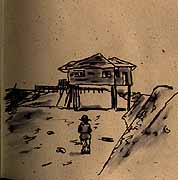
Topsail Island Beach
On Sunday we awoke to the sound of surf and contractors’ ladders
clattering up the neighboring walls. Guzzling morning tea we spotted
a small whale gamboling along just offshore, and lines of pelicans
patrolling the breaking edge of the surfline in military precision,
banking and rolling in sequence. Then Timmy’s Dream, a 50-foot
trawler pulling an array of nets and doors between widespread
out-riggers, followed in the whale’s wake.. surrounded by half
the winged scavengers in North Carolina. When we struggled up
over the residual dune and slid down to the beach, the flotsam
said there was just as much biota beneath the waves as there was
squabbling above it. The shore was littered with a variety of
unfamiliar bivalve shells.. of the clam, scallop, mussel and oyster
persuasions, but generally thicker shelled with more vaulted architectures.
Among the white and yellow skeletons were chunks of siding, random
tools, halfburied expanses of awning canvas, broken studding,
and lovely glistening oblates of quartz begging to be rubbed between
your hands. Flocks of black-headed gulls nattered along the water’s
edge, barely bothering to toddle out of our way, and solitary
long-legged striders purposefully worked the back and forth. We
beachcombed and sketched all the way to a stilted cottage, now
teetering alone and tattered on the wrong side of the frontal
dune, a wounded survivor in the gap-toothed smile of Topsail row.
Peggy opted for a colonial era daytrip, and we set off crosslots
for Moore’s Creek Bridge and 1776. But we had to traverse Orton
County of 1997 to get there, and on a Sunday that means churchyards
full of formal-dressed blacks, and putting greens full of absurdly
dressed whites. Families in the former, mostly men in the latter.
The roads were full of young guys in pickups and loud cars, and
the sheriff was busy playing hideandseek.
After crossing various branches of the Cape Fear River drainage,
and making a few false turns, we came up behind a cluster of rebels,
facing a bunch of loyalists across a small stream which meanders
through a cypress swamp.
(Memo #63)
March 16 Moores Creek Bridge N.C.
Who? N.C. Patriots v. N.C./English loyalists
What? small battle known as the “Concord of the South”
Where? at small creek on road between Wilmington and Fayetteville,
N.C.
When? February 27, 1776
How? creativity and good tactics
Topics: revolutionary sites, the Concord of the South, Tories
in the South
Questions: Why do we know so little about the Revolution's battles
in the South?
|
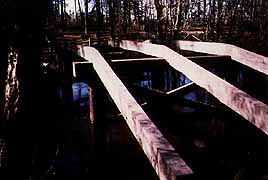
Moores Creek Bridge
|
Ask students to name revolutionary war battles (in fact ask most
adults) and they will probably answer: Bunker Hill, Lexington,
Concord, Yorktown, maybe Quebec, Saratoga, Princeton, and Long
Island. Fewer people remember that much of the war was fought
in the South (battles at Camden, King’s Mountain, Cowpens, Guilford
Courthouse, etc.). A three minute battle at Moores Creek Bridge,
NC, discouraged Loyalists in the South at the start of the revolution.
It has been called the “Concord of the South”.
It is estimated that only a third of the colonial population really
supported the revolution. Thousands of pro-England Tories left
the colonies during the war, settling in Nova Scotia, New Brunswick,
England. While patriots organized minutemen units to support the
rebellion, colonial Loyalists raised their own forces to combine
with British regulars (army troops arriving by ship). A N.C. Loyalist
force of 1600 with highlander members was raised and started southeast
toward Wilmington. Patriot troops moved to block them, choosing
the crossing at Moores Creek Bridge on the major Fayetteville-Wilmington
road as a logical battle site.
The Patriots (a force of about 1000 from several militias) arrived
on February 26, 1776. They dug a trench and breastworks on a slight
rise and set up their two guns to sweep the bridge. Then they
tore up the bridge’s planks and greased the timbers (!).
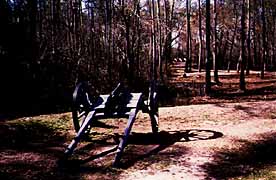
Site of Battle
|
The Loyalists arrived and sent an ultimatum that was refused.
Confused about the identity of Patriot scouts they saw in the
morning fog on their side of the bridge, the loyalist officer
apparently called out a query in Gaelic. The lack of reply convinced
him to order an attack. A small Loyalist group started across
the bridge, driving their swords into the timbers to give themselves
security. They were mowed down and the battle was over. Fifty
Loyalists and one Patriot (John Grady) died
|
Did anyone know that the creek was only five feet deep? In several
battles, lack of knowledge about rivers has lead to massacres
at bridges (Antietam in the Civil War is a hideous example).
The Loyalists of N.C. were discouraged by the action at Moores
Creek bridge and in April of 1776, N.C. became the first colony
to order its delegates to vote for full independence at the Continental
Congress. The British regulars who arrived later in the spring
failed to take Charleston and there was no further action in the
South for two years.
The visitors' center has a diorama of the battle and full size
mannequins wearing the uniforms of the Patriots and Loyalists
(many were in highland garb with kilt, sporran etc). There are
exhibits on the soldiers’ gear and the weapons used. A path lead
down a hillside and through the pine woods to the creek. There
are descriptions of the important North Carolina industry producing
naval stores (see below). The ground is extremely marshy and the
creek has no definite banks. It is perhaps thirty feet wide. Woods
come down to the road on either side of the bridge. Two guns are
still on the slight rise where the Patriots waited and a three
foot earthworks runs along it. The bridge is low and its planks
are missing. It is a small scene for a small battle.
Several monuments have been raised on the battlefield, one to
John Grady and one to the Loyalist dead. The inscriptions praise
all the men (whether Loyalist or Patriot) who fought for their
beliefs. Another monument praised Polly Slocum, wife of a lieutenant
in the fight who apparently rode 65 miles alone and at night to
help the wounded.
3/16.. cont.
You forget how few men were actually involved in Revolutionary battles, and the scale
of events always comes as a surprise at these historic sites.
All of them have a curious familiarity for me, something in the
air out of childhood fieldtrips in New Jersey, following Washington’s
footsteps. Is it the common atmosphere of a miniature stage set,
or does our hallowing of these places induce a charge in them,
leaving a whiff of something like ozone? Or is learning history
a process of creating period rooms in the mansion of our imagination,
and each trip back to that time feels like the memory of a place
we’ve been, with its antiquated smell, and the texture of old
patina? Only 51 men died here, and yet the place is still a window
on the 18th century.
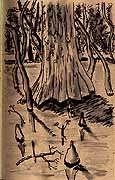
Cypress
|
What was new here for me was my first blackwater cypress swamp,
with the trees kneedeep, and the knees sticking out. A boardwalk
through the swamp to the battle site wiggled through the cypress,
and was dappled in warm sunlight between the shades of the swollen
old trees. Above the battle scene loblolly pines were standing
around in what looked more like a war zone. Two thirds of the
trees had been blown down, sawed up and carted off. Somebody was
using bigger artillery in the piney woods. |
(Memo #64)
March 16 N.C. Naval Stores - N.C.
Who ? North Carolina colonists
What? producers of tar, pitch, turpentine
Where ? pine forests
When? 1600s-1900s
How ? rendering pine resin (much as New Englanders tap sugar maples)
Topics: colonial products, naval stores
Questions: What are naval stores? Why are people (and sports teams)
from North Carolina called "tarheels"? |
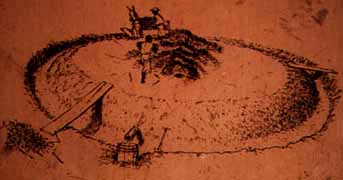
Making Tar
|
It would be fun to do a guide to children’s misconceptions about
professions. A chandlery is not where you sold or bought candles,
a cobbler had nothing to do with cobblestones, a milliner didn’t
mill anything, a tanner didn’t get sunbrown, a mule skinner didn’t
skin mules, and naval stores weren’t markets or places to buy
things. These last were, however, extremely important in American
history, especially for North Carolina.
We tend to neglect certain parts of colonial history, books gloss
over the incredible rice production of antebellum South Carolina,
or the importance of the pine forests of colonial North Carolina
which produced key naval stores.
Naval stores were all the products needed to maintain ships in
the days before plastics and steel. The miles of ropes that rigged
every every large boat were made of natural fibers (sisal, jute,
hemp); their production is a fascinating subject. The sails were
made of cotton canvas, the boats themselves were made of soft
and hard woods. It was crucial to protect and preserve ropes and
canvas and wood as they were attacked daily by wind and rain and
saltwater and rot.The key naval stores were tar, pitch, and turpentine.
All are created by rendering pine resin.
Oil byproducts now are used for many tasks that once needed tar.
Kids today don’t get into trouble as I did for getting tar on
my clothes.
There was an excellent naval stores trail at the Moores Creek
Bridge Historical Park in North Carolina that gave fascinating
details. This trail through the woods emphasized the fact that
England’s naval stores were produced largely by the pine woods
of North Carolina.
England had a huge navy. In 1700 England was dependent on the
Baltic countries for its naval stores which made it vulnerable
to political tactics. To increase production in its own colonies,
the Crown began to pay a bonus for naval stores and in 1706 ordered
its colonies to export naval stores only to England or other English
colonies. By 1720 N.C.had become the top English colony producing
naval stores. The longleaf pine (pinus palustrios) was superseded
by the loblolly pine (pinus taeda) over time, the latter produced
better stores.
The tapping process for pine trees seemed much like tapping sugar
maples. To get pine resin (“crude turpentine"), a tapper uses
a HACK (cutting tool like an adze) to cut a BOX (4 inches deep
by 7 inches long by several inches wide) in the side of a longleaf
pine. Two were usually cut in one tree and an expert woodsman
could cut one in ten minutes. Resin would drip into a pail and
would be collected 7-8 times a season, The box had CHIPPING (cuts)
made above it weekly from March to October to continue the flow.
The flow apparently decreased as the cuts got higher.
(The exhibit didn’t state how rights to pine tapping were given
. Did tappers own pine woods? Were they hired by owners? By the
Crown? What was the yearly round and daily round of the pine tapper?
Did they tap from homesteads?)
Raw turpentine comes straight from the tree. TAR has to be forced
out of pinewood by burning. The tapper makes a thirty foot bowl
like circle in the ground. A pipe goes from the center to a barrel.
Two to three foot pine logs (three inches thick) are stacked like
spokes of a wheel until the pile is ten to fourteen feet high.
The pile is covered with turf and then ignited. The control of
air is critical. Apparently on Day 2 tar begins to flow. This
type of pile would produce 5500 gallons in a week (enough to fill
170 barrels).
PITCH is thick tar. Apparently the tar and crude turpentine are
mixed and heated in large kettles or “surface burns” (clay lined
pits six feet across and four and a half feet deep). The process
involved constant stirring. 3 barrels of tar produced two barrels
of pitch. It sounds like hot, dirty, and quite nasty work. The
illustrations showed Afro-Americans doing the work. Slaves? Were
there tar plantations?
The barrels of tar, pitch, turpentine were taken by raft or boat
to the 5 North Carolina district ports. One half of all naval
stores were shipped from Point Brunswick (modern Wilmington, N.C.)
The Revolution meant England lost the North Carolina naval stores.
I have no idea where its next source was (perhaps the soft wood
forest of Canada). After the Revolution, New England became the
purchaser of North Carolina’s naval stores. Both regions profited.
North Carolina’s future was affected by the appearance of steel
ships. After 1870 the demand for naval stores declined. It would
be interesting to see the statistic on the growth and decline
of naval stores. When did these woods become important for paper
rather than naval stores? There IS still a need for some naval
stores - turpentine is still used for dealing with oil-based paint.
The thirteen colonies were crucial to England for raw materials
- indigo, rice, lumber, and naval stores.












